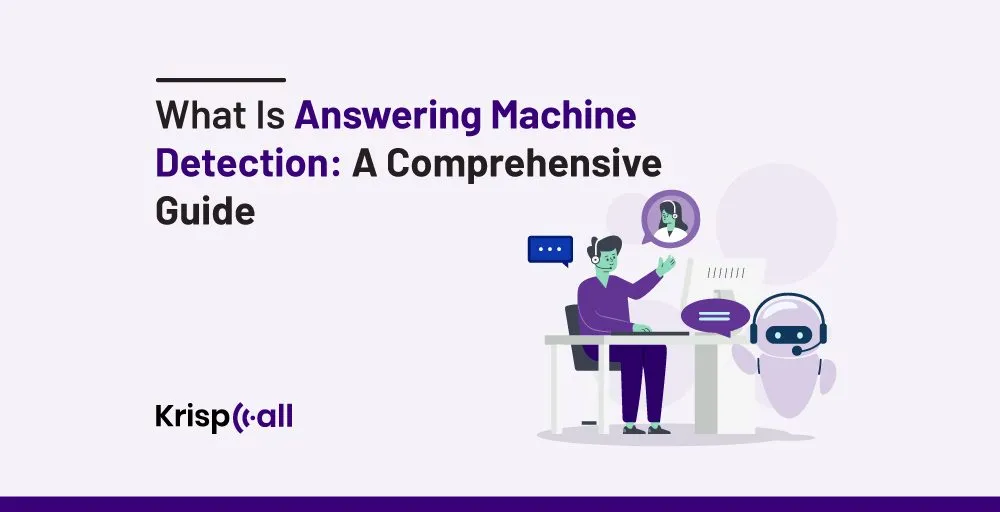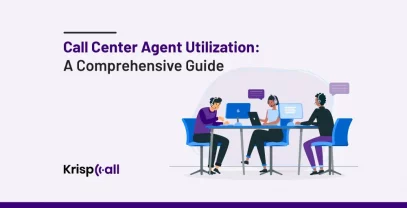Are you tired of your agents spending valuable time 🕒 leaving messages 💬 on answering machines instead of engaging with live customers?
As a call center operator 🧏🏻♂️, the challenge of distinguishing between answering machines and live human beings is essential.
Answering machine detection is a sophisticated technology designed to solve this exact problem. Its pivotal role in modern call centers and its impact on telemarketing strategies has revolutionized calling technology.
In this blog, we will discuss answering machine detection, how it works, its benefits, factors you must consider while implementing AMD, issues with it, and how accurate AMD is.
🔑 KEY HIGHLIGHTS
- Answering machine detection is a technology used in telephony and call center operations to automatically distinguish between answered calls by live individuals or answering machines.
- Answering machine detection works by analyzing the audio characteristics of incoming calls in real time to differentiate between human answers and answering machines.
- AMD enhances customer service by ensuring customers are quickly connected to live agents, minimizing wait times, and improving overall interaction quality.
- Selecting the appropriate solutions is one factor in implementing answering machine detection to ensure effective integration and optimal performance in call center operations.
What Is Answering Machine Detection (AMD)?
Answering Machine Detection, or AMD, is a technology used in telecommunications to recognize whether answering machines or individuals have answered the call. It is also known as automatic machine detection or voicemail detection. It performs this task by scanning the audio signals and patterns during the initial stage of a call.
AMD (Answering Machine Detection) technology relies on studying various things, such as the rhythm of speech and intonation, and comparing them with the more uniform patterns of answering machine messages. Specifically, this process usually involves algorithms analyzing the length of initial silence, how often sounds occur, and what other characteristics relating to audio are present.
Thus, AMD improves the efficiency of contact center software by ensuring that representatives have conversations with real people instead of waiting for voicemails to finish. This results in more customer involvement and better asset use.
How Does Answering Machine Detection Work?
An answering machine detection analysis distinguishes between the answering machine and the human making the pick-up.
Basically, AMD technology evaluates calls as soon as they are answered when a call is placed. If an answering machine is reached, a pre-recorded message will not appear until after the welcome phase and probably until the tone for leaving a message has sounded. Contrary to the automated message, this ensures the entire message is recorded as a voicemail.
Real-time analysis of the sound data enables AMD systems to determine the nature of the response with speed and precision. When detecting an answering machine, the system might end the call or play a pre-recorded message to enhance the efficiency of the contact center or auto-dialing system.
The answering machine detection works automatically as it is integrated into your communication platform, and the process is as follows:
- Initiate a call manually or automatically.
- AMD analyzes the response to identify if it’s a human or an answering machine.
- If it’s a human, the message plays immediately.
- If it’s an answering machine, the message is delayed until the “beep” is detected.
What Are The Benefits Of Answering Machine Detection?
Answering Machine Detection (AMD) enhances contact center efficiency by maximizing agents’ interactions with actual customers rather than dealing with answering machines. In this way, call campaigns become more effective while non-essential calls are decreased, leading to increased productivity and significant cost reduction.
Without implementing answering machine detection, most of your automated calls wind up on a voicemail system, with part of the first message running off before completion due to an early start on recording. So, implementing answering machine detection technology into your calling technology is beneficial and important.
Some of the benefits of answering machine detection are as follows:
1. Cost Savings
The major benefit of using AMD in a contact center is cost reduction. By automatically recognizing answering machines, call centers can easily reduce expenses related to unnecessary phone calls. This reduces all operational costs by avoiding charges imposed for ghost calls, which nobody receives.
This technology helps prevent costs associated with paying when nobody answers the phone. Moreover, agents spend less time on calls that have no value. Consequently, fewer agents are required due to better resource use, decreasing operational costs.
2. Improve Call Center Efficiency
AMD works to make handling calls more efficient by automating detection. This makes it easier to manage calls by ensuring agents are only connected to live calls. When the automated system recognizes answering machines early enough, it speeds up how quickly a call goes through and minimizes how long it takes an agent to receive another call.
By optimizing how phone calls are made, AMD creates opportunities for contact centers in which the same number of agents can answer more phone calls quickly than before. Consequently, it boosts productivity and helps people attain targets easily.
3. Enhance Customer Service
Customer service levels elevate with AMD as agents can spend more time talking to real customers than answering automated questions. Customer interactions are improved while receiving more personalized service. Thanks to AMD, customers no longer have to listen to busy tones, resulting in quicker connections to live people.
AMD also ensures that consumers do not experience the annoyance of constant automated calls. This results in increased satisfaction and loyalty among customers.
4. Optimize Agent Time and Resources
Answering machine detection eliminates the rate of unnecessary calls and increases agent productivity. When they concentrate on valuable client interactions, agents can effectively use their skills and expertise on useful things. This improves the contact center’s performance and raises job satisfaction among the agents.
Concentrating on productive calls could lead to increased success in dealing with clients, improved sales, and resolving issues. This can thereby drive better company output through optimal use of time and resources.
5. Customize Call Handling
AMD enables companies to create custom call routing plans. Most importantly, customization increases the likelihood of productive engagements more than any other factor. In essence, this means configuring the system within the call centers to route calls based on different criteria, such as the caller’s intent or history with the company.
It lessens the transfer of phone calls while improving the settlement of problems by sending clients to the relevant agents or departments. The call center is more capable of responding to and meeting the needs of its customers by customizing it.
6. Reduce Compliance Risks
Call centers should comply with regulatory requirements to prevent regulatory violations. Answering machine detection tries to minimize risks by observing the law and applying strict rules concerning phone calls. One way to avoid governmental rules on call recording and contacting customers is using automated answering machine detection.
By minimizing the chances of non-compliance, contact centers can avoid costly legal issues and penalties. Answering machine detection assures lawful and effective operations through industry regulations.
7. Data Analytics and Reporting
Contact centers value the information generated by answering machine detection systems. The detailed call data gives a perspective on consumer behavior, agent performance, and general call trends. The data can help make informed decisions, improve workflows, and raise service levels.
Advanced reporting options may assist call centers in assessing performance indicators and identifying areas for improvement. Using call analytics, call centers may improve their business strategy, stimulate growth, and achieve better results.
How To Implement Answering Machine Detection?
Answering machine detection does have its many benefits; thus, understanding how to implement it in your business organization is important. Here are 6 steps on how you can implement an effective answering machine detection:
1. Complete Information About Answering Machine Detection
Understanding answering machine detection and its functions is essential before beginning the implementation process. AMD is a technology used in telephone systems that determines if a call was picked up by a person or an answering machine.
It examines things like voice patterns, background sounds, and timing duration to make this assessment. AMD analyzes various factors on inbound calls to distinguish between human and machine responses. It is crucial to understand what AMD is and how it analyzes calls before setting up this technology in a contact center.
2. Select The Appropriate Solution
It is important to acknowledge that different answering machine detection solutions are available, ranging from standalone programs to integrated options within full contact center platforms.
Thorough research is needed to compare the various alternatives and identify the option that best aligns with the individual organization’s unique requirements, budget, and technical specifications. Evaluating the range of answering machine detection solutions on the market is necessary to pick the right fit for your needs.
3. Integrate With Your Current System
After picking a fitting voicemail detection solution, the next step is linking it with your present technology system or call center software. Integration approaches may differ depending on the selected solution.
Closely work with your IT staff or software provider to guarantee an easy integration process. Make sure to successfully tie the new voicemail detection technology into your existing phone or call center systems.
4. Set Detection Parameters
After integrating the solution, configure the detection settings based on your business needs. This involves establishing thresholds for elements like voice tone, duration of quiet periods, and background sound volume to differentiate between human responses and answering machines precisely.
Take the time to set the detection parameters appropriately to ensure accurate identification once the solution is live.
5. Test And Confirm
Before employing answering machine detection in a live working environment, completely assess the system to guarantee its performance and dependability. Sample test calls were performed in various scenarios, such as diverse answering machine styles and voicemail greetings, to judge the detection precision.
Adjust the parameters and settings as required, dependent on the testing outcomes. Conducting thorough tests provides an opportunity to identify any areas for enhancement before full implementation.
6. Provide Training To Your Team
Now that the answering machine detection system is implemented train your staff to utilize this technology optimally. Give them direction on understanding detection outcomes and adapting their method appropriately.
Provide training so team members know how detection results should impact their calls and conversations. Effective call center training is key for seamlessly adopting the new system.
What Are The Issues With Answering Machine Detection?
Answering machine detection does not come without any problems. Here are some issues with answering machine detection:
- Inaccuracy: The technology used for answering machine detection does not always work perfectly. Sometimes, it makes mistakes by thinking that a real person is an answering machine (a false positive). Other times, it mistakenly thinks an answering machine is a real person (a false negative).
- Customer Frustration: When the answering machine detection system makes errors, it can negatively impact customers. False positives may create confusion as a real person hangs after a brief silent call. False negatives could lead to an unnecessarily long message on an answering machine.
- Compliance Issues: Telemarketing call center regulations in some areas restrict the use of AMD, especially if it leads to many abandoned calls. Failing to comply with these regulations can result in fines.
- Limited Effectiveness for Certain Calls: While answering machine detection works well for routine calls, it may not work well for all situations. For instance, it might not be effective for business-to-business (B2B) calls where reaching a live person is crucial.
- Maintenance and Set-Up: Over time, answering machine detection systems require care and adjustment. As voicemail prompts and callers change, the parameters must be updated to maintain accuracy. Initial configuration and integration also require specialized knowledge, which adds complications.
How Accurate Is Answering Machine Detection?
The precision of answering machine detection (AMD) relies on multiple elements, like the quality of the detection algorithms and the straightforwardness of the answering machine messages. Messages that simply say something like “Hello, you’ve reached…” are easier for AMD to identify correctly, whereas more intricate messages or background noise could cause confusion.
Even the most sophisticated AMD technologies may occasionally misclassify, producing incorrect identifications of answering machines or false positives and negatives that a line is live when it actually isn’t. The system is not perfect, and errors are still possible on rare occasions.
The accuracy of answering machine detection (AMD) can vary significantly based on the technology and algorithms used. Advanced AMD systems can achieve high accuracy rates, often correctly identifying answering machines and live human responses.
However, no system is perfect, and false positives and negatives can occur, particularly with varying voice patterns and call conditions. Continuous machine learning and improvements of AI in call centers enhance AMD’s capabilities, but challenges remain. While AMD can be highly effective, it is not infallible and should be part of a broader call management strategy.
Conclusion
Answering machine detection improves contact centers’ productivity, economy, and general performance. It promises major benefits to the communication platform by increasing enterprise efficiency, reducing costs, and enhancing productivity. As technology advances, it will present more possibilities for improving call center operations. Adopting this technology can bring technological development and lead to major call center advancements in the long term.🚀
Moreover, Answering machine detection minimizes human downtime and increases productivity by automating the detection of answering machines. This is useful for quickly connecting with live representatives while reducing wait times. By streamlining operations and enhancing agent performance, a call center experience that is more result-oriented, customer-oriented, and successful can be created.🌟
FAQs
What Is A False Positive In Answering Machine Detection?
A false positive in answering machine detection refers to the system incorrectly identifying a live person’s voice as an answering machine, leading to an inaccurate classification.
What Is A False Negative In Answering Machine Detection?
A false negative in answering machine detection refers to a situation where the system fails to identify an actual answering machine. This means the system mistakenly thinks that a person has responded to the call when it was an actual answering machine.
What Are The Different Types Of Answering Machine Detection Technologies?
The different types of answering machine detection technologies are rule-based systems, machine learning algorithms, and hybrid approaches, combining both methods to leverage the strengths of both methods.
Can Answering Machine Detection Be Integrated Into Existing Call Center Software?
Yes, Answering Machine Detection can typically be integrated into the existing call center software. This integration is feasible because AMD solutions typically use APIs or software modules that can be incorporated into the call center’s infrastructure.
Is Answering Machine Detection Compliant With Regulations Like GDPR And CCPA?
No, the Answering Machine Detection (AMD) is generally not compliant with regulations like GDPR and CCPA. Alternatives like manual call monitoring or more advanced machine learning-based detection methods may be better suited to meet compliance requirements.





